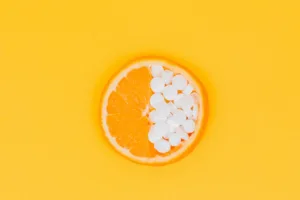Joint pain isn’t just discomfort; it’s an interruption, a life-altering inconvenience. And unfortunately, chronic joint pain is not a rare occurrence at all. According to the CDC, nearly one in four Americans has doctor-diagnosed arthritis – which is just one of several common causes of joint pain.
But nature, with its vast remedies, might just have a solution virtually tucked away in the spice cabinet. Have you ever looked at turmeric and thought, “That little yellow spice could be my ticket to relief”? If not, then you might be surprised about what you’re going to learn today.
While modern medicine undoubtedly provides efficient drugs to tackle joint pain, such as Voltaren’s active ingredient Diclofenac, these same drugs often come with severe side effects after prolonged use. If you want to avoid suffering from stomach ulcers and other nasty side effects, then read on to learn why curcumin might be the best natural alternative when it comes to treating various kinds of joint pain.
Understanding joint pain
You wake up, stretch, and ouch! – there’s that familiar twinge. Joint pain is a tricky thing. It’s not as simple as having an occasional ache. It can stem from countless sources – from inflammation to muscle strains, and from the simple passage of time wearing down our body’s natural cushions to more complex reasons.
Some folks notice their fingers don’t bend as smoothly or that their knees give them a bit more sass than they used to. If that sounds like you, you’re not alone, and it’s a good sign you should chat with someone in the know.
Why do joints protest?
There are several causes of joint, but the most common of them all is undoubtedly osteoarthritis. This degenerative joint disease is usually the result of normal wear and tear as we age, so it’s no surprise that it’s affecting a huge percentage of elderly people across the globe. As osteoarthritis patients see the protective tissues of their joints get slowly ground away, they will experience friction and hence pain in their joints.
Another common cause of joint pain is rheumatoid arthritis, an autoimmune disease that causes chronic inflammation in the joints. Unlike osteoarthritis, which primarily affects older individuals, rheumatoid arthritis can occur at any age and can cause severe pain and joint deformity if left untreated.
Gout is yet another cause of joint pain. It emerges suddenly, manifesting as intense pain, conspicuous redness, and noticeable swelling in the joints. This condition arises from the accumulation of so-called “uric acid crystals” within the joints. Certain dietary choices, like indulging in red meats, seafood, or excessive alcoholic beverages, can indeed exacerbate its onset.
Finally, tendinitis and bursitis are two more common causes of joint pain that are often the result of overuse or repetitive movements. Tendinitis occurs when the robust tendons, responsible for connecting our muscles to bones, become inflamed. Meanwhile, bursitis involves the inflammation of the bursa – these are small fluid-filled sacs designed to minimize friction between bones, tendons, and muscles. They act as our body’s natural buffer, but they too can succumb to wear and tear.
What symptoms should I look out for?
Understanding the nuances of joint pain symptoms can be a pathway to pinpointing the root of the discomfort and navigating toward the right solution. While the telltale signs might vary, there are some universal markers to watch out for.
This includes stiffness in the joint, an evident swelling, pronounced redness, a warm feeling, and a restricted range of motion. Persistent joint discomfort shouldn’t be taken lightly; medical counsel is key for a precise diagnosis and subsequent care.
Beyond these primary indicators, joint pain occasionally comes hand-in-hand with supplementary challenges: an overwhelming fatigue, a sense of weakness, or hurdles in executing mundane tasks. Such extended symptoms underscore the profound influence of the pain on one’s day-to-day existence.
To add another layer, joint pain isn’t restricted to just one locale. Whether it’s your knees feeling the strain, the hips bearing the burden, shoulders in discomfort, or the elbows and wrists crying out, each location offers a clue. The specific site of pain becomes a vital piece of the puzzle, guiding healthcare experts in both diagnosis and tailoring an effective recovery roadmap.
Meet Curcumin: nature’s answer to joint pain?
Ever notice how turmeric leaves a golden stain on everything? That’s curcumin at work. But it does more than color our foods and countertops. It may very well be a lifeline for those of us grappling with joint pain.
Turmeric doesn’t just add flavor to our curry; its essence, curcumin, is like Mother Nature’s special little anti-inflammatory agent, making it perfect for those dealing with joint issues.
Why curcumin can heal our bodies
Picture this: Hundreds, if not thousands of years ago, someone, somewhere, was using turmeric and curcumin to soothe their ailments. From ancient Indian ayurvedic practices to traditional Chinese medicine, turmeric wasn’t just a spice; it was a healing agent.
While these old cultures of course didn’t know anything about the actual science behind turmeric’s healing properties, the rich history melds seamlessly with today’s scientific findings, painting a full picture of curcumin’s role in health.
But how exactly does it work?
For those who love a good research chat, curcumin’s inner workings are like a thrilling detective novel. It’s not just numbing the pain, like a Paracetamol pill – it’s addressing the root issues. And it primarily does so by inhibiting inflammation inside the human body, and most important for this article, in your joints.
Multiple studies and researchers are now nodding in agreement about the benefits of curcumin on joint health. For example, a 2021 meta-analysis weighing up a myriad of scientific studies that tested curcumin for a number of different issues, ranging from brain functions to depression, and, of course, joint pain.
The conclusion? Curcumin is an effective compound to treat a variety of diseases and shows promising results to treat osteoarthritis, rheumatoid arthritis, and other common causes of joint pain.
How to welcome curcumin into your day
If you’re sold on curcumin and want to try it out, the way to go is specialized curcumin supplements. The main reason behind this is that only a tiny fraction (just about 3%) of the turmeric root is actually curcumin. And additionally, curcumin is known to have a fairly poor absorption rate in the human body.
So, if you’re ready to order a curcumin supplement, be sure that it is not only a pure curcumin extract, but that it also comes with an absorption-enhancing addition.
Currently, the most effective way to consume curcumin for medical reasons is to buy a nano-curcumin supplement. This type of supplement includes super tiny particles of curcumin. In fact, they are so small that they can easily penetrate the fatty tissues of cells – leading to a more than 42.6 times higher absorption rate than conventional curcumin.
The most popular brand offering nano-curcumin is NanoCumin. Based in New York, this company has made itself a name for providing super high-quality curcumin products that boast the highest absorption rate on the market. You can order their products from the official NanoCumin website to anywhere in the US.
If you’re not satisfied with this solution for some reason, then your best bet is to get a curcumin supplement with piperine, the smart name for black pepper extract. As several studies have shown, the addition of piperine can boost the bioavailability of curcumin by up to 20 times – not as much as nano-curcumin, but still a respectable increase.
Another effective complement to enhance curcumin uptake is good ol’ fat. In concrete terms, combining your curcumin consumption with healthy oils will help your body to absorb them properly. Some curcumin supplements already include essential and/or specialized oils, but diving deeper into this might be a bit too much for this article.
How much curcumin should I take?
Scientists are yet to find a clear consensus on the perfect curcumin dosage, but fortunately, a number of studies have provided us with a rough indication of what an ideal curcumin intake looks like.
Generally speaking, most studies seem to rely on roughly 1,000 mg of pure curcumin per day, applied for at least two to three months. But of course, the perfect curcumin dosage varies depending on factors such as gender, weight, age, and perhaps most importantly, the treatment purpose.
If you ask the Arthritis Foundation, patients suffering from arthritis and other joint-nagging conditions should consume between 1,000 to 1,500 mg per day.
It’s important to know that these numbers may not apply to nano-curcumin due to its ultra-high bioavailability.
But let’s be clear: while curcumin is amazing, it’s not a magic potion. Taking too much can upset your tummy, and it might not jive well with certain medications or conditions. So, before you start sprinkling turmeric on everything or popping supplements, try to work with the dosage suggestions above and talk to your physician if you think you may need to up your intake.
The bottom line
Isn’t it fascinating how nature often has the answers we seek? Curcumin, found in the humble turmeric, holds promise for those of us trying to make peace with our protesting joints. With its rich history and backing from modern science, it might just be worth a try. But always remember: knowledge and moderation are key.





